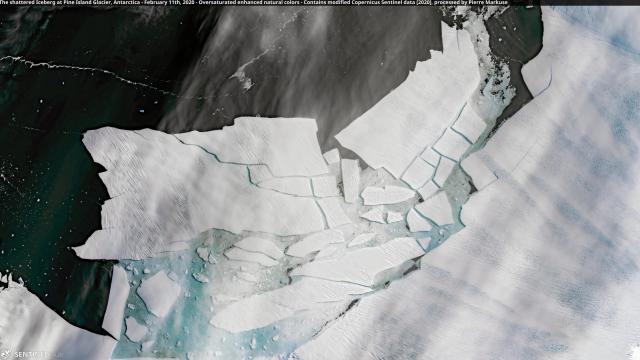Antarctic has been on one the past few weeks. It reached 18 degrees Celsius last week, a new record high for the continent. Scientists have found warm water creeping farther under its most vulnerable glacier. Other researchers dropped a little remote-operated robot under the same icy “superhighway,” recording eerie footage of an under-icescape in flux.
And that brings us to this weekend, when a massive iceberg splintered off Pine Island Glacier, arguably the continent’s second-most endangered hunk of ice. The huge “˜berg has already fractured into a series of relatively tiny ones as it drifts into the open water of the Amundsen Sea. The crackup is another worrying sign of the watery future that awaits us.
Pine Island Glacier is nominally a fun glacier, or at least as fun as a chunk of ice that could collapse and inundate millions of coastal homes can be. It’s acronym is PIG. It tweeted for a while. And well, actually, that’s it in the fun department.
In the not-so-fun department is its propensity to unleash massive chunks of ice. The most recent is a “˜berg roughly the size of San Francisco, known as B-49, along with a host of other suburb-sized pieces of ice. Satellites captured the great breakdown over the weekend, and the images as the ice moves seaward continue to astound. Satellite image-processing wizard Pierre Markuse released new imagery (shown at the top of this post) on Wednesday, showing crisp white ice sliding into the dark waters off Pine Island. In the iceberg swarm’s wake, an azure slurry of ice and seawater burbles against the new glacier front.
The scene has a stark beauty to it, until you realise just what it shows. Consider West Antarctica as a fortress that safely holds the West Antarctic Ice Sheet, a huge hunk of land ice that would raise sea levels more than 10 feet if it melted. Guarding this bounty of ice are bedrock and massive glaciers that spill out over the ocean. It’s a nice system that’s worked to keep the ice sheet largely protected since the Miocene 7 million years ago.
But now it’s under attack from warm water, and Pine Island Glacier is one of the prime weak spots in the region’s defences. It and the Thwaites Glacier next to it both sit on bedrock that slopes downward. That’s allowed warm water to cut deeper and deeper under the glaciers, creating a larger section of floating ice that’s also getting progressively thinner.
As more ice flows through the glaciers and down to the sea, instability rises. That can lead to large calving events like the one that just happened. But it could eventually also lead to something called marine ice cliff instability, where the towering cliffs at the edge of floating ice become too tall and begin a process of collapsing in on themselves.
That could set off unstoppable retreat of Pine Island Glacier. The big calving event is one of a handful that have occurred in the past two decades. These events are happening at a quickening pace, and there are signs the ice they’re unleashing is getting weaker.
“The recent history for PIG calvings includes B-44 in 2017 and B-46 in 2018,” Christopher Shuman, an ice scientist at NASA, told Earther in an email. “B-44 shattered into many pieces within about six weeks of its initial calving, and no piece remained big enough for NIC [National Ice Centre] to track. B-46 was a little more “˜together,’ but most of that broader calving event shattered similarly to B-49, with just one iceberg big enough to track. This stands in stark contrast to the larger bergs that calved in 2001, 2007, and 2013, which held together for much much longer, in some cases multiple years.”
The sorry state of the ice indicates Pine Island Glacier’s health continues to suffer. The rate of ice loss across Antarctica has sped up three times faster in the past five years compared to the preceding 20. West Antarctica is ground zero for these changes. And the changes may not be over for the year. Shuman warned this “austral summer season has been so warm there that there well may be more calving events,” though predicting exactly when and where is still a challenge.
